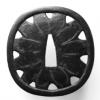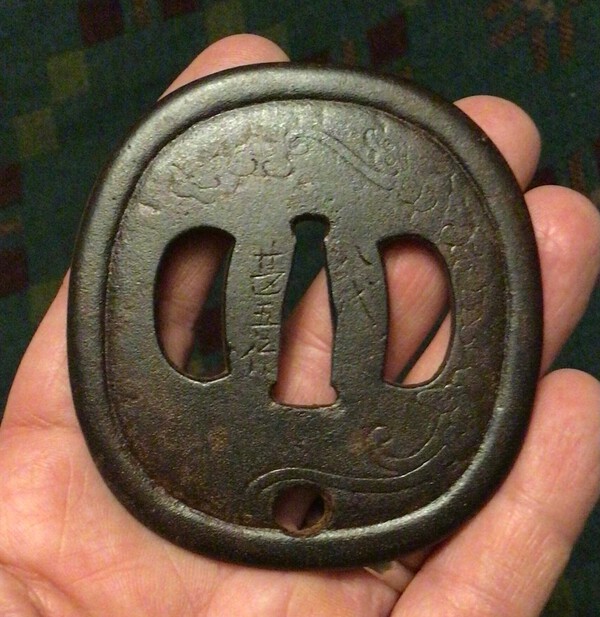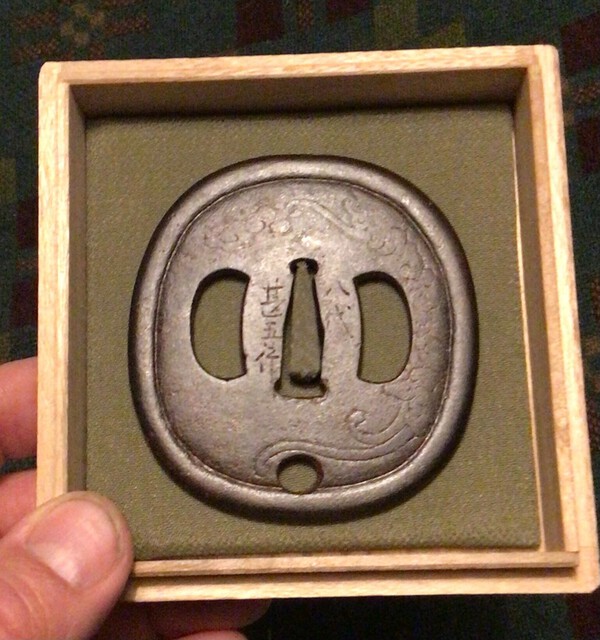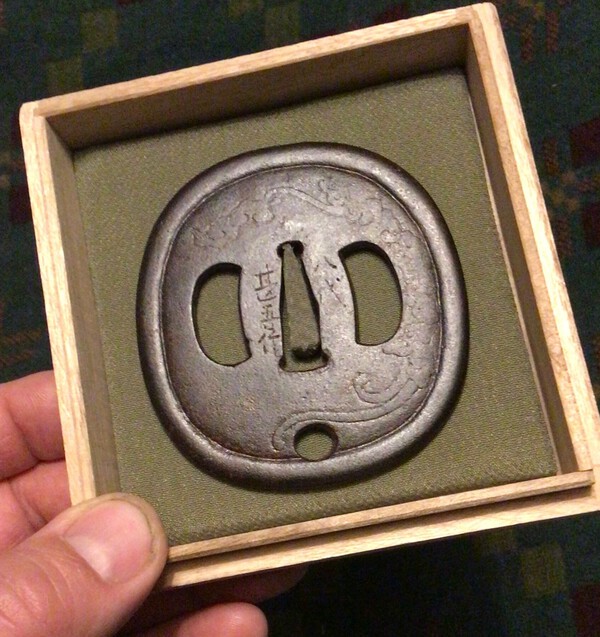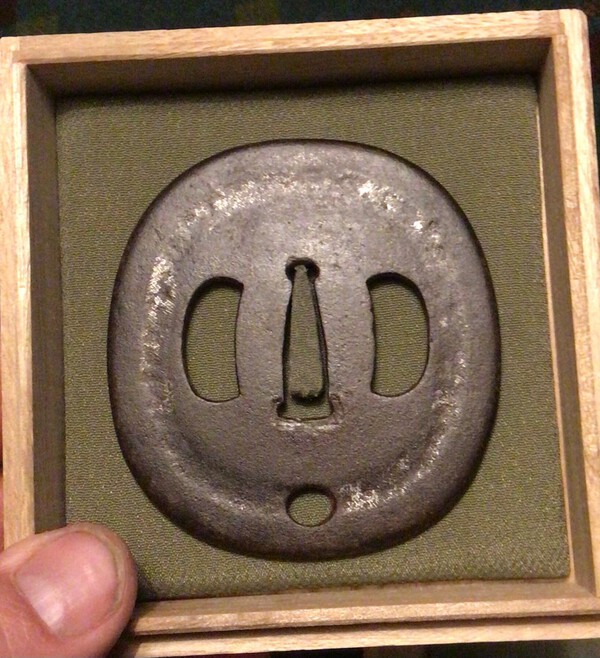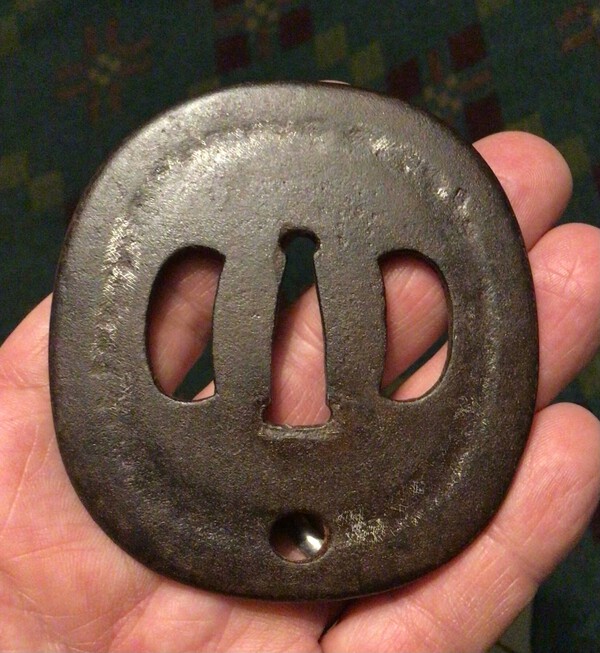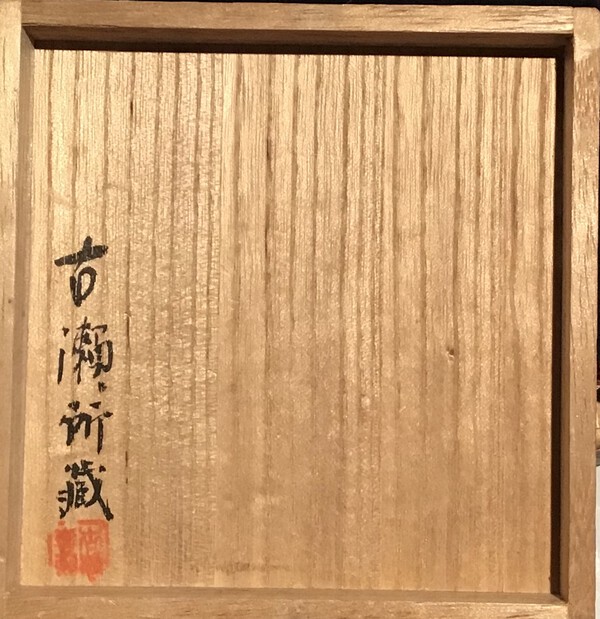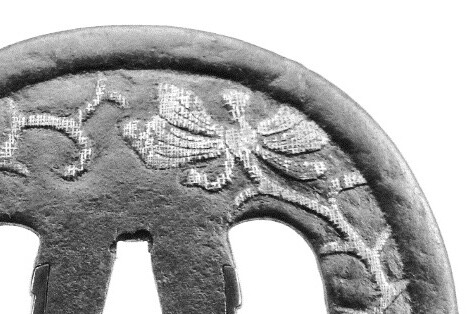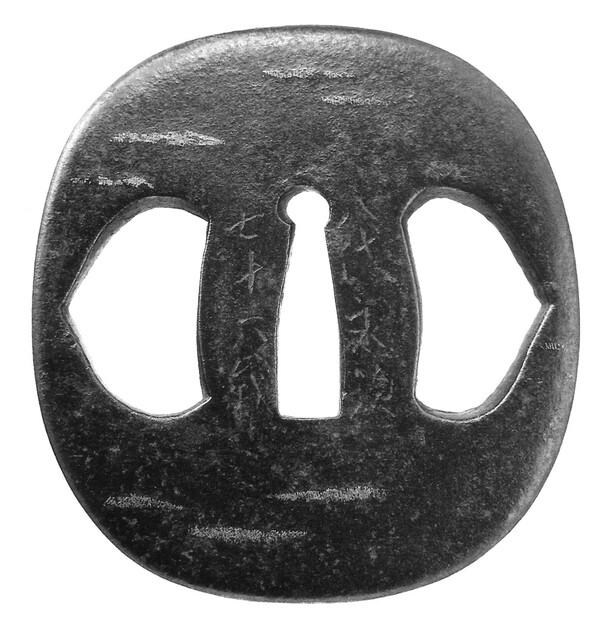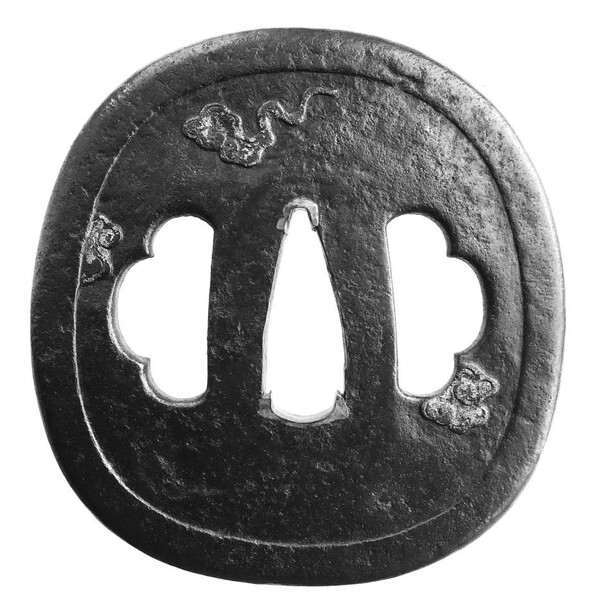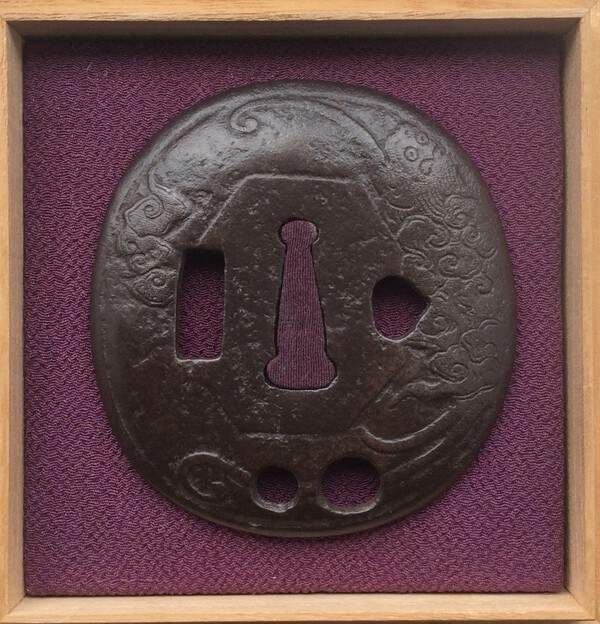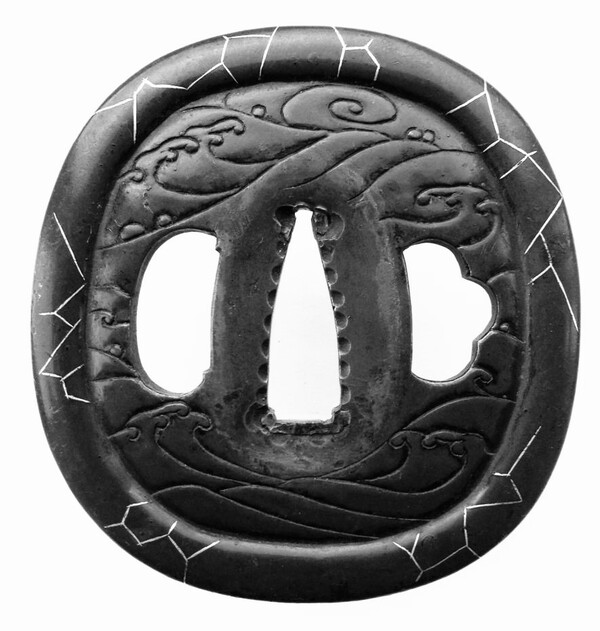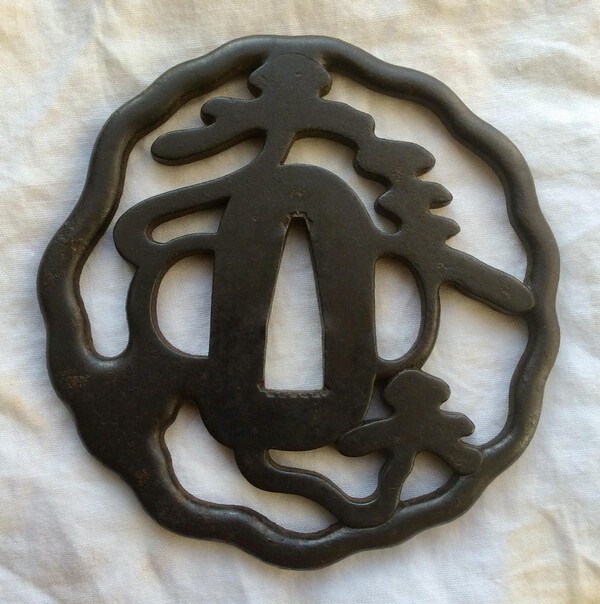-
Posts
241 -
Joined
-
Last visited
-
Days Won
1
Content Type
Profiles
Forums
Events
Store
Downloads
Gallery
Everything posted by Michael 101
-
Hello Darren, sorry to say that this is definitely a modern cast copy. if it was sold to you as original or it was expensive then I would see if you could get a refund. the main giveaway points are its crudeness, signatures carved in soft metal ( eg copper brass etc ) would be much more crisp than your pictured show. worth reading some of the articles you will find here on cast copies so that you can get your eye in. by the way we have all bought these at the start so take it as a lesson ( hopefully not an expensive one ) kindest regards Michael
-
Hello Steve, thank you for your feedback. I relieved to read Im not the only one that had been struggling and scratching their head over this one. Its nicely written as you say, fingers crossed another member can point us both in the right direction. This is the associated tsuba for others to see. kindest regards Michael
-
Dear members, does anyone recognise the signature of the author of the attached hakogaki ? I dont wish to trouble anyone over the full translation just looking to find out who wrote it. its not a familiar one to me and Im unable to work out the signature - hoping someone will be able to assist? kindest regards Michael
-
Please mark as sold and remove listing. contribution will be sent to board on receipt of payment. kindest regards and thanks Michael
-
i have now added this tsuba to ebay but the price offer to members still stands to those who buy direct rathe than via ebay. I will also now include post of postage on the members direct buy price. https://www.ebay.co.uk/itm/255545695016 kindest regards Michael
-
-
Dear members, i offer the attached signed Jingo tsuba for sale. design of the water dragon to the front and simply carved reverse with light silver inlay. the style of the dragon and signature is typical of the last two Jingo generations ( 4th and 5th master ) as is the shape of the nakago ana. size 8.05cm x 7.52cm x 0.42cm x 0.35cm SOLD
-
-
I just see absolutely stunning examples of the work of the first two Hayashi masters - No 5 I think I would consider doing anything short of murder to obtain. No3 is a rare signed Shigemitsu ( 2nd Hayashi ) which is I am pretty certain Juyo rated ( as is no 5 for certain ) the pictures do no justice to the iron quality but do serve the purpose for design comparison. very interesting post kindest regards Michael
-
I rather like this one - and for its original owner to bother adding a shakudo insert to one of the hitsuana I think he did too. the carving is slightly naive but I think it gives it more charm than more precise work. From its carving style and the seppa dai shape I would think Hizen. nice find ! Michael
-
Many thanks Michael
-
Thank you. the tsuba itself was rumoured to have originally come from a shrine in the Kyoto region - do you think the signature is a person or a place? kindest regards Michael
-
Dear members could anyone assist with the signature on the attached tsuba box ? a translation would be really helpful and should anyone know anything about the author / collector and could share it would be greatly appreciated. no hakogaki just a noted to 2nd Jingo on the lid with this signature and seal on the inside. Kindest regards Michael
-
Hi Ray, i think this might be the Hosoge flower. Hosoge meaning noble or precious flower, a stylised ( not real ) flower based on the lotus / Chinese peonies and introduced as a Buddhist motif in Japan around the 8th century AD. Here is variation on a 2nd Jingo example. very popular design on Jingo tsuba especially on their wan shaped ( hizen influenced ) tsuba so might be some connection here and more knowledgeable member could expand on. kindest regards Michael
-
Two Jingo examples showing clouds 1) signed 3rd master. 2) Reverse side of an unsigned 5th master. Michael
-
Hi Les, I certainly do not recall seeing any Jingo daisho either in person or published apart from the set you have and suspect they are very rare indeed. I agree that yours are unlikely 2nd master and more probable 3rd or 4th. Great find. Dirk - a truly great tsuba with a very powerful atmosphere and the portrayal of the geese is just perfect and couldn’t be anyone other than the first master. Im pleased too see your still enjoying that one. Kindest regards Michael
-
Lovely example Dirk, so what with your 1st master, Currans 2nd master I better add a 3rd master Jingo. happy Christmas to all. michael
-
Hi Pete, the tsuba at the top of the thread but I understand your question but the other ( Torigoye example ) at least has a typical Kanshiro dote mimi. Where as the first example I feel has too many points against it being Kanshiro so perhaps ko kinko is more likely. i dont like the hitsu ana shape on either and prefer more Higo influence like the attached example by the first kanshiro. kindest regards michael
-
I understand the cast comment but think unlikely, perhaps more likely to have suffered rusting at some point and treated to restore the colour a long time ago - but not really possible to be certain from pictures alone. The square akasaka also so signs of similar treatment. Both are very good powerful Akasaka designs. kindest regards michael
-
Very nice tsuba. Although there are similarities between this tsuba and the 2nd Kanshiro tsuba, especially in the carving of the waves and the decoration of the mimi, I dont think that the tsuba in question was made by Kanshiro. It is well known that Ko Kinko workers were of great influence to the Higo schools and that is what I believe you have here. Basically its overall shape and the carving of the mimi would be very unlikely for Kanshiro, also the hitsu ana shape and the seppa dai area again rarely seen in kanshiro works so when taken together I think ko kinko is far more likely. the 2nd kanshiro was apprenticed at a young age to the Goto school and this had an influence in the carving of his waves, so they differ greatly from the first master but have closer affinity with the ko kinko and goto form which makes it harder to distinguish between the schools in cases like this one. If it were mine I would certainly consider a gentle clean or restoration as I think it could easily look quite magnificent afterwards and worth the investment. Great find. Kindest regards michael
-
Hi Mikolaj, i agree with the opinion of tosa mychin for the irregular shaped pine tree, looks a very nice example. the Kanshiro is very nice indeed, especially with its provenance. Beautiful iron by the look of your pictures. the other is slightly harder from pictures alone it is always helpful to include full measurements including thickness at the centre and at the mimi to help judgement. My thought on this one is Hayashi however the inlay work is questionable in terms of quality versus good the carving of the tsuba so possibly added later. Or it could be a late higo copy ( these tend to be slightly thinner hence my suggestion to include measurements where possible ) but the iron quality and colour looks suggests earlier work. kind regards michael
-
Hi Roger, when you say ugly hitsu ana excavations- did you actually mean the marks around the nakago ana ? if so then I dont think these spoil this tsuba - its just a sign that the tsuba has been adjusted and mounted to a sword and not spent its life sitting in a box - so in many ways adds to the history of the tsuba. this style of inlay was very popular in the 19th century and look to be the same age as the tsuba - although it would be hard to be certain if it were original or added slightly later, although my money would be on the former. Kindest regards Michael
-
Hello Peter, This design ( tomi matsu ) is thought to have originated with the 1st Kanshiro master who’s version was carved in a more detailed style also using kebori engraving - and then adapted by Matachichi ( 1st Hayashi master ) into the more stylised version on which your tsuba is based on. The design was used throughout the Hayashi and Kamiyoshi schools ( for example see attached version by Kamiyoshi Fukanobu) and also many others in the late Edo period. The slightly crude carving on the tsuba you have shown suggests to me another hand maybe a late Edo copy by Tsuboi or amateur samurai work. The iron looks old and I dont think its modern. The crudeness is around the kogai hitsuana and also the inner edges to the sukashi and soft lines to the surface which may be attempted artificial ageing or slight damage it’s difficult too judge. Kindest regards Michael
-
Hi Luis, To help get quality feedback its very important that you add dimensions in mm giving height, width and thickness at the seppa dai and also the mimi. You will also need to add pictures showing the front and reverse straight on as seppa dai shape is important and is not possible to judge from your good bat angled pictures. Hints at being a goid tsuba BTW. Kindest regards Michael
-
Not fake just late Edo production, possibly cast. It was a popular style to copy in this period. Kindest regards Michael


